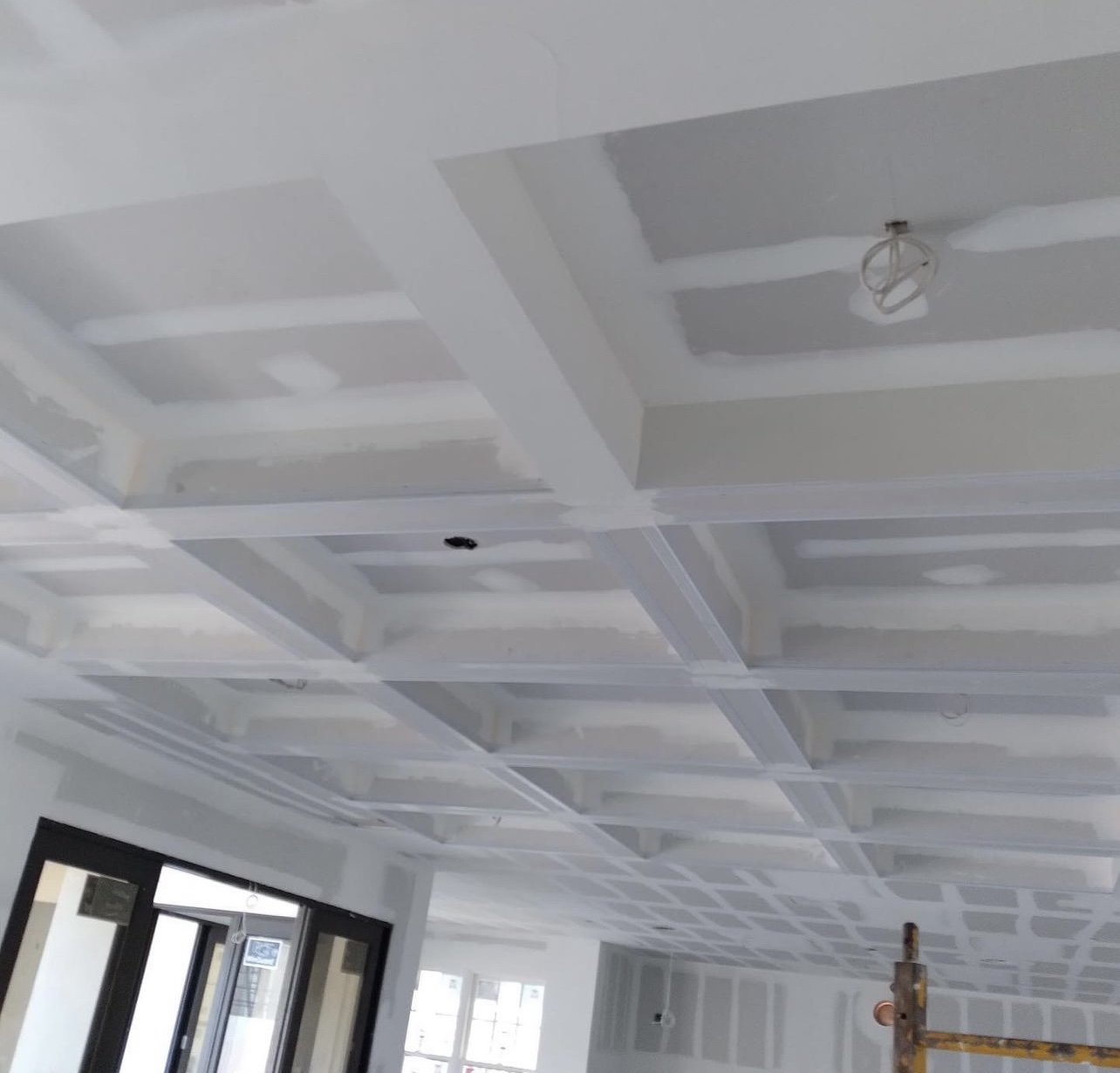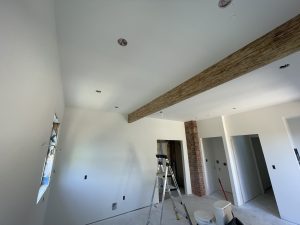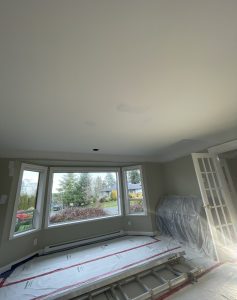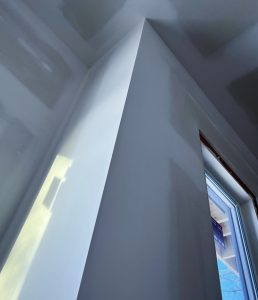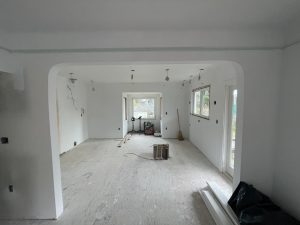Drywall is a crucial element of modern home construction, forming the backbone of interior walls and ceilings. In large residential homes, drywall installation must be precise, as the scale of these homes demands smooth, continuous surfaces that contribute to the home’s overall aesthetic and structural integrity. While drywall provides a sturdy, reliable interior finish, it is not immune to damage, especially in homes with expansive square footage. Whether dealing with small dents, cracks, or moisture-related issues, understanding drywall maintenance and repair is essential for homeowners to keep their living spaces looking impeccable.
In this detailed guide, we will explore common drywall problems in large homes, offer maintenance tips for homeowners, and explain when it’s best to seek the help of a professional drywall contractor. By following these guidelines, homeowners can protect the investment they’ve made in their property and maintain the beauty and function of their drywall for years to come.
The Role of Drywall in Large Residential Homes
In any home, drywall serves as the foundation for walls and ceilings, offering a smooth, paintable surface that complements any interior design. In large residential homes, drywall takes on an even more significant role. High ceilings, open-concept living areas, and vast rooms require more extensive drywall installations, making the quality of installation and maintenance vital to the home’s overall appearance. Poor drywall installation or neglected maintenance can detract from the elegance of a luxury home, making imperfections like cracks, uneven surfaces, and dents more noticeable.
For larger homes, drywall also contributes to the property’s structural integrity, helping insulate the interior and improve energy efficiency. Well-installed drywall can also provide soundproofing, an essential feature in large homes where noise can easily travel through open spaces. Furthermore, drywall can be made fire-resistant or moisture-resistant, which is especially important in areas such as basements, kitchens, and bathrooms.
Because drywall is such an integral part of a home’s structure and design, keeping it well-maintained should be a priority for homeowners, especially in large residential properties. Let’s explore some of the most common drywall problems that homeowners in larger homes may encounter and how to address them.
Common Drywall Issues in Large Residential Homes
Drywall, despite its versatility and durability, is susceptible to various issues over time. The following are some of the most common problems homeowners in large homes face:
Cracking
Cracks are a common issue, particularly in homes with large, open spaces and high ceilings. As homes settle, stress can develop on the drywall, leading to small cracks. These often occur near doors, windows, or in the middle of large walls, where the drywall may experience the most strain.Moisture Damage
Moisture is one of the biggest threats to drywall, especially in areas like bathrooms, kitchens, or basements. In large homes, the presence of multiple bathrooms and large kitchens increases the potential for moisture-related issues, such as water stains, warping, or even mold growth behind the walls.Dents and Holes
In any home, the walls are susceptible to dents, chips, or holes from everyday activities. Large homes, with their expansive living spaces, are particularly prone to these minor damages, whether caused by furniture moving, children playing, or even pets scratching at the walls.Nail Pops
Over time, the nails used during drywall installation can begin to protrude from the surface of the wall, causing visible bumps. These “nail pops” are often the result of natural house movement, shifts in temperature, or changes in humidity levels. They can be unsightly and require attention to maintain a smooth surface.Peeling Tape
Drywall tape is used to cover the seams between drywall sheets. Over time, this tape can peel or bubble, leading to visible lines on the wall. This issue is often caused by improper installation or environmental factors that weaken the adhesive.Uneven Finishing
Large homes often feature extensive wall surfaces that need to be perfectly smooth and seamless. Uneven finishing, whether due to poor installation or inadequate sanding, can disrupt the visual appeal of these expansive walls and ceilings.
Tips for Maintaining Drywall in Large Homes
Maintaining drywall in a large home requires both preventive and reactive measures. Regular care ensures that drywall remains pristine, contributing to the home’s overall appearance. Here are some key maintenance tips:
1. Regular Inspections
It’s easy for small issues to go unnoticed in large homes simply due to the sheer size of the space. Homeowners should perform regular inspections of their drywall, paying special attention to high-traffic areas, bathrooms, and kitchens where moisture is prevalent. Regularly inspecting the ceilings is also crucial, especially in homes with high ceilings or complex architectural features. Catching minor problems early can prevent larger, more costly repairs later.
2. Addressing Cracks Early
Cracks in drywall are inevitable as homes settle over time, particularly in large homes where expansive wall areas may experience more structural stress. Small, hairline cracks can be filled with a flexible joint compound. For larger cracks, using mesh tape over the crack before applying joint compound can reinforce the repair and prevent the crack from reopening. Always sand the area smoothly and repaint it to maintain a flawless appearance.
3. Dealing with Moisture Issues
Moisture can be a significant problem in areas like bathrooms, basements, and kitchens. In large homes, where there are multiple bathrooms or extensive kitchen areas, it’s essential to control humidity levels and ensure proper ventilation. Installing exhaust fans in bathrooms and dehumidifiers in basements can help reduce moisture levels. If drywall shows signs of moisture damage, such as water stains or warping, it’s important to replace the damaged sections and address the underlying cause of the moisture to prevent future issues.
4. Repairing Dents and Holes
Small dents and holes are easy to fix with a patching compound. Simply fill the hole, smooth it with a putty knife, and sand the area once it’s dry. For larger holes, homeowners will need to use a drywall patch. This involves cutting a piece of drywall to fit the hole, securing it in place with drywall tape and screws, and finishing the repair with joint compound. In a large home, it’s essential to ensure that repairs are well-blended with the surrounding wall to avoid visible patches.
5. Fixing Nail Pops
Nail pops can create visible imperfections in drywall. To fix this, carefully remove the protruding nail, drive a new screw into the drywall slightly above or below the original nail hole, and cover the area with joint compound. After the compound dries, sand the area and touch up the paint to restore a smooth surface.
6. Reattaching Peeling Tape
Peeling drywall tape can be reattached by applying joint compound over the area and pressing the tape firmly back into place. Once dry, sand the area and apply a fresh coat of paint. In large homes with extensive drywall surfaces, it’s important to inspect all seams for signs of peeling tape and address it before the issue becomes widespread.
7. Preventing Moisture Damage in High-Humidity Areas
In high-humidity areas such as bathrooms, moisture-resistant drywall (greenboard) can be installed to help prevent damage. Large homes with multiple bathrooms should have moisture-resistant drywall in every wet area to minimize the chances of mold and water damage. Regularly check these areas for any signs of moisture, like discoloration or bubbling, and promptly address any leaks or ventilation issues.
Professional Drywall Maintenance and When to Hire a Contractor
While many drywall repairs can be handled by homeowners, large homes often require professional expertise for more extensive repairs or for projects where precision is essential. Here are instances when it’s advisable to hire a professional drywall contractor:
1. Extensive Cracks or Structural Damage
If cracks are extensive or appear to be related to structural issues in the home, professional help is required. A contractor will assess whether the drywall needs to be replaced or if more serious repairs are necessary to prevent future damage.
2. Water Damage
Drywall that has been exposed to water for extended periods may develop mold or rot, which requires specialized handling. Professionals can ensure that all damaged drywall is removed and replaced with moisture-resistant material, and they can also address the root cause of the water issue.
3. Major Renovations
For homeowners undertaking large-scale renovations or additions to their home, hiring a professional drywall contractor is essential. Professionals will ensure that new drywall installations match the existing structures and provide a flawless finish.
4. Finishing Large Spaces
In large homes, drywall finishing needs to be seamless and perfect. Achieving this level of quality over vast wall spaces requires professional skill, especially in homes with high ceilings or intricate architectural features. Professionals can provide high-quality finishes that blend perfectly with the home’s design.
Conclusion
Maintaining drywall in a large residential home is an ongoing process that requires vigilance and attention to detail. By addressing small issues like cracks, dents, and moisture damage early, homeowners can prevent more significant problems and maintain the pristine appearance of their walls and ceilings. However, for extensive damage, complex repairs, or when ensuring perfect finishing in large spaces, hiring a professional drywall contractor is the best choice.
By following the tips outlined in this guide, homeowners can protect their investment, preserve the aesthetic appeal of their large homes, and ensure their drywall remains in excellent condition for years to come.

